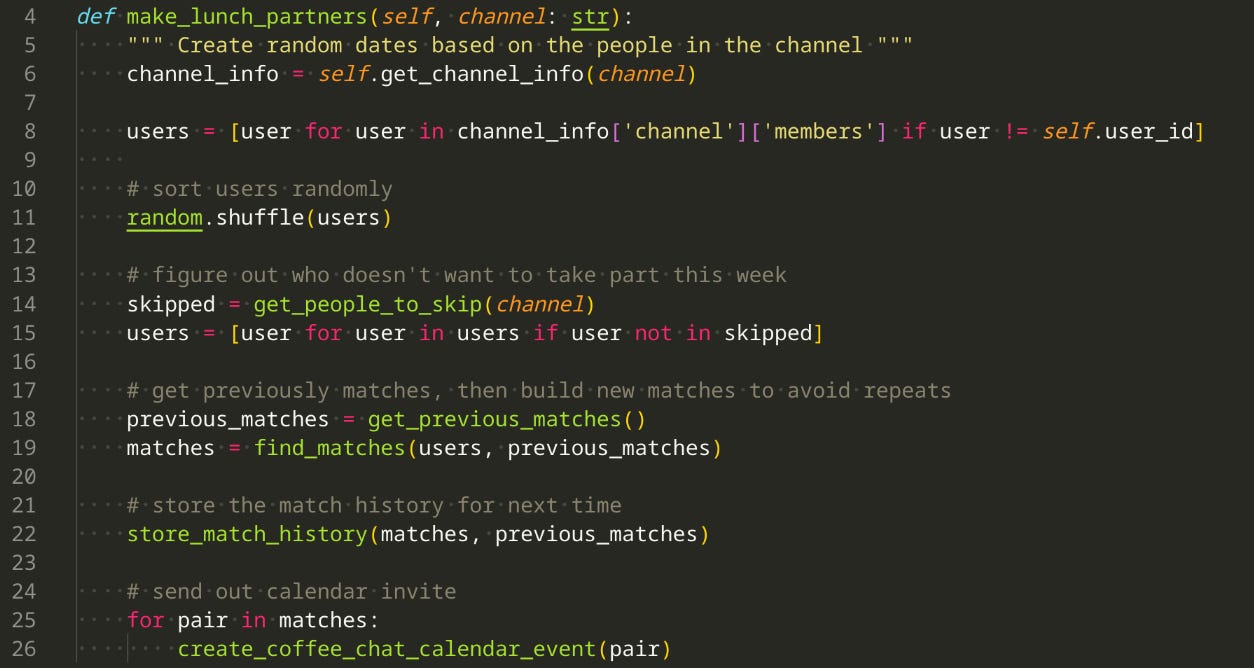Coffee chats are a great way for people to get to know each other a little better. Randomized coffee chats between employees can help make everything a little easier. As an organisation changes, or grows, there’ll be more and more people who don’t know each other. It makes collaboration easier if you know each other, even if the coffee chat topic is unrelated to work.
In Schibsted, we set up these coffee chats a long time ago. It became so popular that a large portion of our employees took part, in multiple different locations and sub-organisations. People still reach out to me about them, asking when they’re coming back. So I figured I’d write up how to run your own coffee chats.
The premise
Connect employees, at random, to increase the overall productivity of the company.
The method
From a list of employees, group employees into pairs or 3s at random.
Send a calendar invite to both employees for 30 minutes.
The topic agenda is up for employees to decide.
In a large organisation, it will likely begin with “so what do you do?”
There isn’t need for structure to these chats. However, some people find it easier with a topic in mind. Using check-in questions can reduce the awkwardness for those who feel it.
Store the list of employees, to avoid repeats.
It ends up being some simple code like this, with the bulk of the extra code being the integration with Slack or Google Calendar:
Implementation
Our work-chat platform is Slack, so we used a Slack channel.
Every week, the coffee-chat bot would post a message which users could react with an emoji to avoid being paired each week. Typical reasons: vacation periods in different countries, or being too busy. If people left the channel, it was unlikely they would rejoin. Therefore making it easier for them to stay in the channel, while skipping a session, increased the number of people involved on a frequent basis.
In the first year, around 200 people joined coffee-chats, connecting 800 unique combinations of employees. By the the time stopped, over 500 people had joined - with over 4000 unique combinations. Many different units and sub-organisations had their own, as did each location.
Instructions for employees
Join the appropriate Slack channel
#oslo-coffee-chats
#stockholm-coffee-chats
The Slack bot 🤖will automatically match you with a random coworker once a week
When you have been matched, the bot will suggest a time to meet and send you a calendar invite 📅.
Reach out to your co-worker via Slack! Check if the time fits for you both. If not, find a time that does.
When you have a time and place to meet, grab a coffee and make a new connection! 🙌
Practical considerations
Sometimes these are known as “speed dates”, however the term might be uncomfortable for people. Rebranding as “coffee chats” removes that.
Some people may consider themselves too busy to join. It is better that people skip one time, rather than feel too much pressure and never join.
Coffee chats are a great way to facilitate skip-level meetings between bosses and employees.
Why stop?
I left the company for some time, and when I came back, there wasn’t much time for me to focus on these things. In my absence, alternatives like Donut were used - but they didn’t quite work as well as the original bot. It’s also pretty expensive, considering the original implementation was around 200 lines of code.
In the same time-frame, the Slack API had changed, making it difficult to get the bot running again. Instead, now I encourage teams to do it via Google Sheets - simple, easy to set up.
We’ll probably start them up again soon. It’s on my to-do list. Surprisingly, it’s one of the “enablement” activities that I’ve had the best feedback from, despite being relatively low effort. Give it a go in your organisation!





